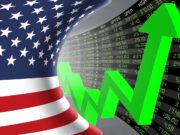Standing at the bustling crossroads of Baltimore’s Inner Harbor, a place where I’ve witnessed the ebb and flow of economic tides over the years, I find myself reflecting on the journey of the U.S. economy. As 2023 draws to a close, we stand on the brink of a new year that promises both challenges and opportunities. The air is thick with anticipation and speculation, much like the fog that often blankets the harbor in the early mornings. The U.S. economy, having navigated the tumultuous waters of a global pandemic, political upheaval, and technological disruption, is now sailing into the uncharted territory of 2024.
This moment in time is particularly significant. The decisions made and the paths chosen in the next twelve months will have lasting repercussions on our economic landscape. Will the economy continue its recovery trajectory, or are we headed towards unanticipated challenges? The answers to these questions are as complex and varied as the people who ponder them.
In this article, we will delve into various aspects of the U.S. economy as projected for 2024, exploring the forecasts of renowned financial institutions, the intricacies of the stock market, the anticipated monetary policies, and the ever-evolving labor market. Our journey will also take us through the potential impacts of international trade and emerging markets, and the risks and opportunities that lie ahead.
As we embark on this exploration, let us remember that the U.S. economy is more than just numbers and forecasts; it is a reflection of our collective efforts, ambitions, and resilience. It is a story of businesses big and small, of workers in every field, and of families planning their futures. As we peer into the horizon of 2024, let us do so with a sense of purpose and preparedness, ready to navigate the uncertainties and seize the opportunities that await.
Section 1: Economic Growth and GDP Forecasts
As we turn the pages of the economic calendar to 2024, the growth trajectory of the U.S. economy becomes a focal point of discussion and analysis. After a period marked by recovery and recalibration post-pandemic, the Gross Domestic Product (GDP) forecasts for 2024 paint a picture of cautious optimism mingled with uncertainties.
GDP Growth Predictions for 2024
- According to leading financial institutions like Goldman Sachs, the U.S. economy is expected to dodge a recession in 2024, showcasing resilience in the face of global economic headwinds. Goldman Sachs forecasts a 2.1% GDP growth for 2024, which notably surpasses the consensus view on Wall Street and the more conservative 1.5% estimate from the Federal Reserve. This projection suggests a scenario where the U.S. economy not only stabilizes but also finds a steady growth trajectory despite global challenges.
- Contrasting Views: Other analysts and institutions might present differing views, reflecting the inherent uncertainties in economic forecasting. These could range from more optimistic scenarios, driven by technological advancements and policy interventions, to more cautious predictions, considering potential global economic slowdowns and domestic challenges.
Factors Influencing GDP Growth
- Consumer Spending: As a significant driver of the U.S. economy, consumer spending will continue to play a crucial role in shaping the GDP growth trajectory. Trends in consumer confidence, household income levels, and employment rates will be key indicators to watch.
- Government Policies: Fiscal and monetary policies will be pivotal in 2024. The government’s approach to taxation, spending, and regulatory frameworks can either fuel growth or pose hurdles, depending on their alignment with the broader economic objectives.
- Global Economic Trends: The U.S. economy does not operate in isolation. Global economic health, encompassing trade relations, geopolitical events, and foreign market performances, will influence the domestic GDP growth rate.
The Role of Technology and Innovation
- The impact of technological advancements and innovation cannot be understated. Sectors like artificial intelligence, green energy, and biotechnology are expected to be at the forefront of driving economic growth. The pace at which these technologies are adopted and integrated into various industries will be a determinant factor in the GDP growth narrative.
Section 2: The Stock Market and Investment Landscape
As 2024 unfolds, the U.S. stock market presents a kaleidoscope of possibilities and challenges, reflecting the broader economic outlook. Investors, analysts, and corporations alike turn their gaze toward market indices and investment trends to decipher the potential trajectory of the stock market in this pivotal year.
Stock Market Performance Predictions
- S&P 500 Index: Forecasts for the S&P 500, a barometer of U.S. stock market health, vary among major financial institutions. Goldman Sachs, for instance, predicts the index to rise, reaching 4,700 points by the end of 2024, marking a 5% increase from current levels. This growth is anticipated to be more subdued compared to the significant rally seen in recent years, especially in technology stocks. Morgan Stanley, on the other hand, projects the S&P 500 to stand at 4,500, signaling a more cautious outlook. These predictions reflect a blend of optimism and pragmatism, acknowledging the potential for growth amid a landscape of economic uncertainties.
- Sectoral Analysis: The performance of different sectors will likely be uneven. Technology, healthcare, and renewable energy sectors are expected to continue their upward trend, driven by innovation and increasing demand. In contrast, sectors heavily reliant on consumer discretionary spending might face challenges if economic growth does not meet expectations.
Investment Strategies for 2024
- Diversification and Risk Management: Given the mixed predictions and potential volatility, diversification across asset classes and sectors becomes crucial. Investors might lean towards a combination of growth stocks in emerging industries and stable, dividend-paying stocks in established sectors.
- Emphasis on Sustainability: Environmental, social, and governance (ESG) criteria are increasingly influencing investment decisions. Companies with strong ESG profiles might attract more investment, as sustainability becomes a key consideration for both individual and institutional investors.
- Technology-Driven Investments: With the growing influence of artificial intelligence and digital transformation, technology-driven investment opportunities, including in fintech and biotech sectors, will likely be areas of focus for many investors.
Monetary Policy and its Impact on Investments
- The Federal Reserve’s monetary policy, particularly regarding interest rates, will play a significant role in shaping the investment landscape. The anticipated approach of maintaining rates until late in 2024, as per Goldman Sachs’ prediction, could influence investor behavior, affecting everything from bond yields to stock valuations.
Section 4: Employment and Labor Market Trends
As we venture further into 2024, the U.S. labor market emerges as a critical aspect of the economic landscape. Employment trends and workforce dynamics are poised to reflect not only the economic health of the nation but also the broader social and technological changes underway.
Employment Trends and Labor Market Conditions
- Job Growth Sectors: Certain industries are expected to continue their trajectory of job growth, particularly in technology, healthcare, and renewable energy sectors. These industries benefit from long-term trends such as digital transformation, an aging population, and a shift towards sustainable energy sources.
- Declining Sectors: Conversely, industries struggling to adapt to technological advancements or facing reduced demand may see a decline in employment. This could include sectors heavily reliant on traditional manufacturing processes or those impacted by evolving consumer preferences.
- Remote Work and Technological Impact: The labor market in 2024 will also be shaped by ongoing trends in remote work and the integration of AI and automation. These factors could lead to shifts in job distribution, the emergence of new types of employment, and changes in workplace culture and productivity.
Section 5: Emerging Markets and International Trade
The role of emerging markets and international trade remains a pivotal component of the U.S. economy as we look towards 2024. These elements not only contribute to the country’s economic growth but also represent potential areas of risk and opportunity in the global marketplace.
Emerging Markets and U.S. Economic Growth
- Influence of Emerging Markets: The economic health and policies of emerging markets will significantly impact U.S. exports and investment flows. While there may be opportunities for growth, Morgan Stanley’s cautious outlook on emerging markets, particularly in regards to China’s economic challenges, indicates potential headwinds.
- International Trade Agreements: Trade agreements and policies will continue to shape the U.S. economy’s interaction with the rest of the world. Negotiations and revisions of trade deals, tariff policies, and economic alliances will play a crucial role in determining the country’s trade balance and economic diplomacy.
Section 6: Risks and Challenges
As with any economic forecast, the outlook for 2024 comes with its share of risks and challenges. These potential hurdles are essential for businesses, investors, and policymakers to understand and prepare for.
Identifying Potential Risks
- Geopolitical Tensions: Ongoing and emerging geopolitical conflicts can have a significant impact on the U.S. economy, affecting everything from energy prices to international trade routes.
- Inflationary Pressures: Inflation remains a key concern, with its potential impact on consumer spending, business costs, and overall economic stability.
- Domestic Policy Shifts: Changes in domestic policies, particularly those related to taxation, healthcare, and industry regulation, could have far-reaching effects on various sectors of the economy.
Mitigating Risks
- Strategies for Businesses and Investors: To navigate these uncertainties, businesses and investors may need to adopt flexible strategies, incorporating risk management and scenario planning into their decision-making processes.
- Role of Policymakers: Effective policymaking will be crucial in mitigating economic risks. This includes balancing fiscal and monetary policies to support growth while managing inflation and addressing structural challenges in the economy.






